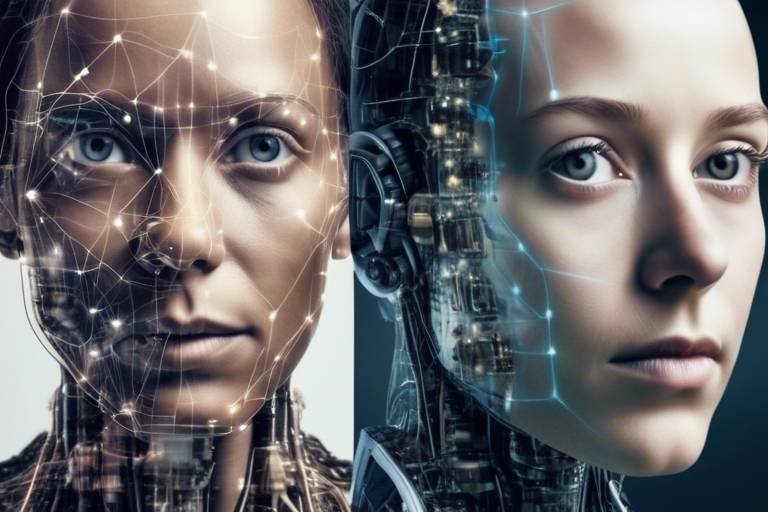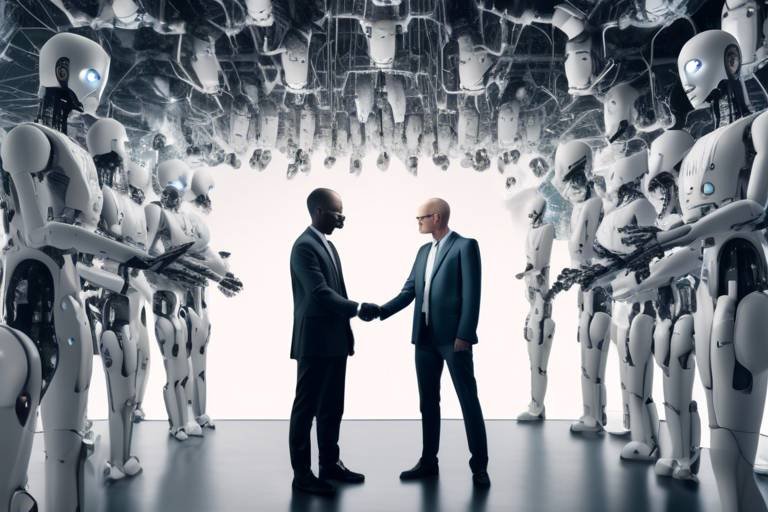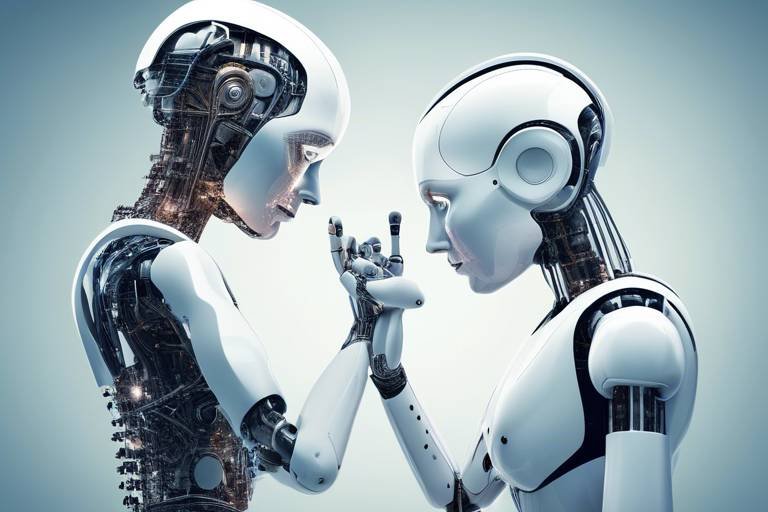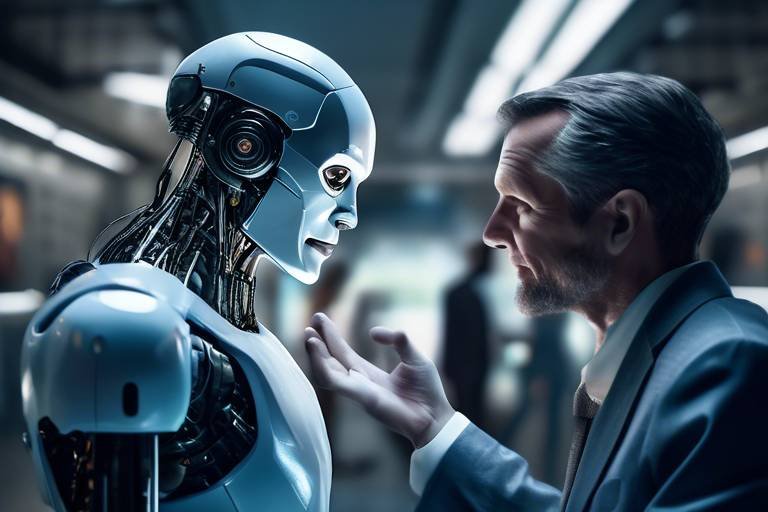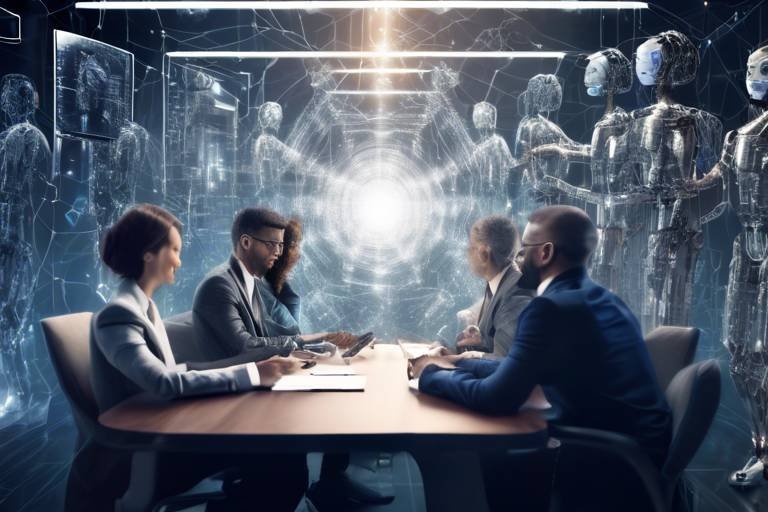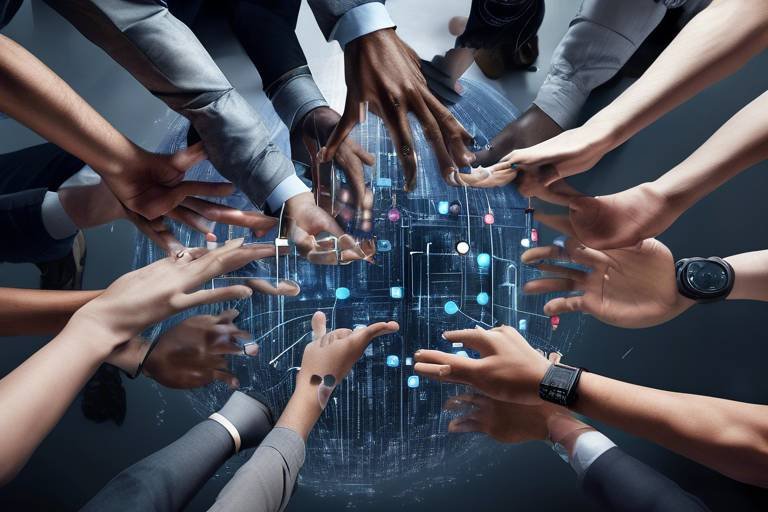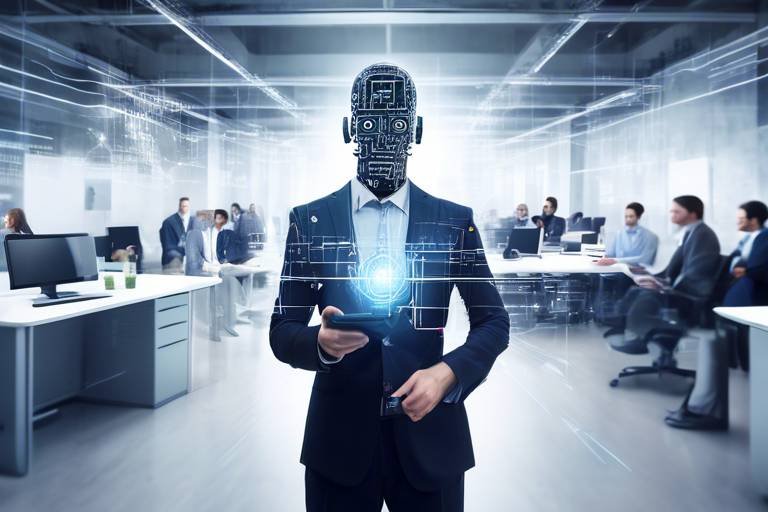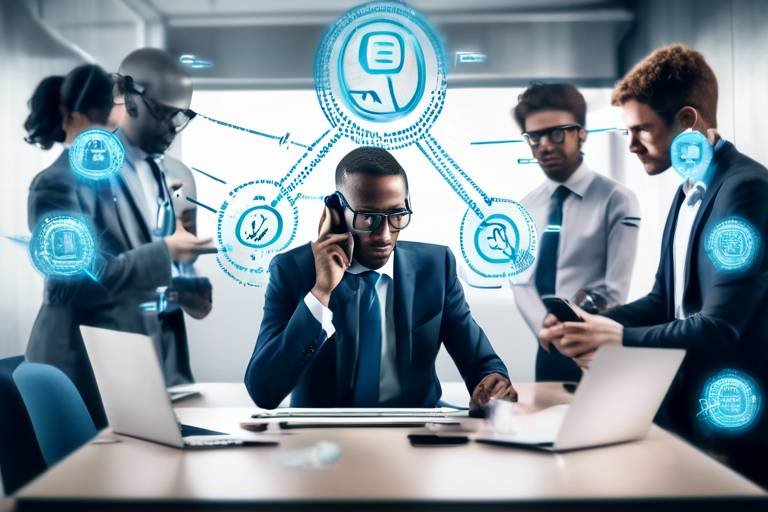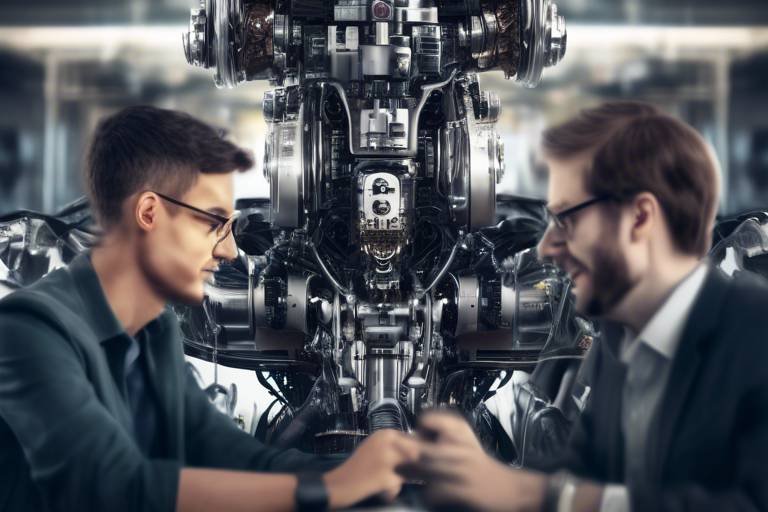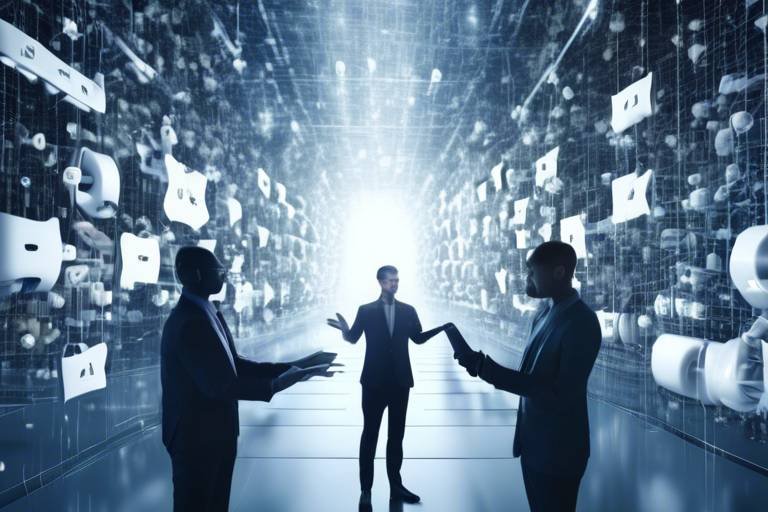Changing the Face of Human Collaborations with AI
In today's fast-paced world, the way we collaborate is undergoing a radical transformation, thanks to the rise of Artificial Intelligence (AI). From enhancing productivity to fostering creativity, AI is not just a tool; it’s becoming a partner in our collaborative endeavors. Imagine having a colleague who never sleeps, always ready to provide insights, streamline processes, and help you make informed decisions. Sounds like a dream, right? Well, that dream is becoming a reality as we explore the myriad ways AI is reshaping teamwork across various sectors.
AI is revolutionizing collaboration by breaking down traditional barriers. It allows teams to connect and communicate effortlessly, irrespective of their geographical locations or time zones. Picture a diverse group of individuals from different corners of the globe, each bringing unique perspectives and skills to the table. With AI-powered tools, these individuals can share ideas, brainstorm, and innovate as if they were in the same room. The possibilities are endless, and the potential for creativity and problem-solving is soaring to new heights.
However, this transformation is not without its challenges. As we embrace AI in our collaborative processes, we must also navigate the complexities that come with it. Issues such as data privacy, reliance on technology, and the need for human oversight are crucial considerations that require our attention. We must strike a balance between leveraging AI’s capabilities and ensuring that human intuition and creativity remain at the forefront of our collaborations.
As we delve deeper into this topic, we will explore the evolution of AI in collaboration, the benefits it brings to teamwork, the challenges we face, and what the future holds. Join us on this exciting journey as we uncover how AI is not just changing the face of human collaborations but enhancing the very fabric of how we work together.

The Evolution of AI in Collaboration
The journey of artificial intelligence (AI) in the realm of collaboration has been nothing short of remarkable. From its inception, AI has evolved through various stages, gradually integrating into our daily workflows and fundamentally changing how we work together. The seeds of AI were planted in the mid-20th century, with early computers performing simple calculations and tasks. However, it wasn’t until the advent of machine learning and data analytics that AI began to show its true potential in enhancing human collaboration.
Key milestones in this evolution include the development of natural language processing (NLP) in the 1980s, which allowed machines to understand and generate human language. This breakthrough paved the way for more intuitive communication tools that we rely on today. As AI algorithms became more sophisticated, they started to analyze vast amounts of data, providing insights that were previously unattainable. For instance, in the 2000s, the introduction of AI-driven project management tools began to revolutionize how teams coordinated their efforts.
Fast forward to today, and we see AI embedded in various collaborative platforms, making teamwork more efficient and productive than ever before. The integration of AI in tools like Slack, Trello, and Microsoft Teams demonstrates how technology can streamline communication and project management. These platforms utilize AI to automate mundane tasks, allowing team members to focus on what truly matters—creative problem-solving and innovation.
Moreover, the rise of cloud computing has facilitated the growth of AI in collaboration. With the ability to access data and tools from anywhere in the world, teams can work together seamlessly, regardless of their physical location. This shift has been particularly significant in the wake of the global pandemic, which forced many organizations to adopt remote work practices. AI has played a crucial role in enabling this transition, ensuring that teams remain connected and productive even when apart.
As we look to the future, the evolution of AI in collaboration is likely to continue at an unprecedented pace. Emerging technologies such as augmented reality (AR) and virtual reality (VR) are set to further transform how teams interact and collaborate. Imagine a world where teams can meet in a virtual space, collaborate on projects in real-time, and even simulate complex scenarios—all powered by AI. The possibilities are endless, and the potential for enhanced collaboration is truly exciting.
In summary, the evolution of AI in collaboration has been a dynamic journey marked by significant technological advancements. From simple computational tasks to sophisticated AI-driven platforms, the integration of AI into collaborative processes has reshaped how we work together. As we continue to embrace these changes, it’s essential to stay informed about the implications and opportunities that AI presents in the collaborative landscape.
- What is the role of AI in collaboration? AI enhances collaboration by automating tasks, improving communication, and providing insights that help teams make better decisions.
- How has AI changed teamwork dynamics? AI has streamlined workflows, facilitated remote collaboration, and enabled real-time communication, making teamwork more efficient.
- What are some examples of AI tools used in collaboration? Popular tools include Slack, Microsoft Teams, and Trello, which utilize AI for task management and communication.
- What challenges come with AI integration in teams? Challenges include data privacy concerns, reliance on technology, and the need for human oversight to ensure ethical use of AI.

Benefits of AI in Teamwork
In today's fast-paced world, the integration of Artificial Intelligence (AI) into teamwork is transforming the landscape of collaboration. It's like having a supercharged assistant that not only helps you get things done but also enhances the overall quality of your work. The benefits of AI in teamwork are numerous, and they extend beyond mere efficiency. They touch on aspects of communication, creativity, and decision-making, all of which are crucial for successful project outcomes.
One of the most significant advantages of AI is its ability to improve communication among team members. Imagine being part of a project where everyone is on the same page, regardless of their location. AI-powered communication tools facilitate real-time interactions that break down geographical barriers. Whether you're in New York and your team member is in Tokyo, AI ensures that distance is no longer a hurdle. This seamless connectivity fosters a sense of unity and collaboration that can lead to innovative ideas and solutions.
Moreover, AI streamlines workflows, allowing teams to focus on what truly matters. By automating routine tasks, AI frees up valuable time for team members to engage in more complex problem-solving. For instance, consider a marketing team that spends hours compiling data from various sources. With AI, data analysis can be automated, providing insights in a fraction of the time. This not only enhances productivity but also leads to better decision-making. When teams have access to accurate, real-time data, they can make informed choices that drive projects forward.
To illustrate this, let’s consider a scenario where a software development team is working on a new application. With AI tools, they can:
- Automate testing processes, reducing the time needed for quality assurance.
- Utilize predictive analytics to foresee potential issues before they arise, allowing for proactive adjustments.
- Enhance collaboration through AI-driven project management tools that keep everyone aligned on tasks and deadlines.
AI also enhances data analysis, which is crucial for making informed decisions. By leveraging machine learning algorithms, teams can analyze vast amounts of data quickly and accurately. This capability allows organizations to identify trends, understand customer behaviors, and ultimately tailor their strategies for better outcomes. The result? Teams that can pivot and adapt swiftly to changing circumstances, ensuring they remain competitive in their respective fields.
Furthermore, the creative potential of teams is amplified when AI is involved. Think of AI as a creative partner that offers suggestions, generates ideas, and even assists in brainstorming sessions. For example, marketing teams can use AI tools to analyze successful campaigns and generate new concepts based on previous successes. This collaborative synergy between human creativity and AI's analytical prowess can lead to groundbreaking ideas that might not have emerged in a traditional setting.
In summary, the benefits of AI in teamwork are profound. From enhancing communication and streamlining workflows to improving data analysis and fostering creativity, AI is revolutionizing how teams collaborate. It’s like having a powerful ally that not only helps you work smarter but also inspires you to reach new heights. As we continue to embrace these technologies, the future of teamwork looks not just efficient, but also incredibly exciting.
- How does AI improve communication in teams?
AI tools facilitate real-time interactions, enabling team members to communicate seamlessly regardless of their location. - Can AI replace human creativity in teamwork?
While AI can assist in generating ideas, it complements human creativity rather than replacing it, allowing for innovative solutions. - What are the main challenges of using AI in teamwork?
Challenges include data privacy concerns, reliance on technology, and the need for human oversight to ensure ethical use.

AI-Powered Communication Tools
In today's fast-paced world, where teams are often scattered across different continents, have emerged as game-changers. These innovative platforms not only facilitate real-time collaboration but also enhance the overall efficiency of teamwork. Imagine being able to connect with a colleague in Tokyo while you're sipping coffee in New York, all without missing a beat in your project timeline. That's the magic of AI in communication!
One of the standout features of these tools is their ability to break down geographical barriers. With advanced algorithms and machine learning capabilities, AI can analyze communication patterns and suggest optimal ways for teams to engage. For instance, platforms like Slack and Microsoft Teams leverage AI to prioritize messages, ensuring that the most important information is highlighted. This means you can focus on what truly matters without getting lost in a sea of notifications.
Moreover, AI-driven communication tools often come equipped with smart features that enhance user experience. For example, they can analyze the tone of messages and provide feedback or suggestions to improve clarity and engagement. This is particularly useful in diverse teams where misunderstandings can arise due to cultural differences. By promoting a clearer exchange of ideas, these tools foster a more inclusive and productive work environment.
Another fascinating aspect of AI communication tools is their integration with chatbots and virtual assistants. These digital helpers can manage routine inquiries, schedule meetings, and even provide instant updates on project statuses. Imagine a scenario where a team member asks a chatbot about the latest project metrics. Instead of waiting for a colleague to respond, the chatbot can deliver the information instantly, allowing the team to maintain momentum. This not only saves time but also empowers team members to focus on more complex tasks that require human insight.
Furthermore, the rise of language translation technologies within these platforms has revolutionized global collaboration. AI can now translate messages in real-time, enabling team members who speak different languages to communicate effortlessly. This capability is crucial for multinational teams, as it not only enhances understanding but also builds camaraderie among members from diverse backgrounds. Imagine brainstorming ideas in a meeting where everyone can contribute in their native language—how empowering is that?
As we look toward the future, the potential of AI-powered communication tools seems limitless. With ongoing advancements in natural language processing and machine learning, we can expect these tools to become even more intuitive and responsive. They will not only help teams communicate better but also foster a culture of collaboration that transcends traditional boundaries. In a world where collaboration is key to success, embracing these AI technologies is not just an option; it's a necessity.
- What are AI-powered communication tools?
These are platforms that utilize artificial intelligence to enhance communication among team members, enabling real-time collaboration and improving workflow efficiency. - How do chatbots improve team communication?
Chatbots automate routine tasks, provide instant information, and help manage inquiries, allowing human team members to focus on more complex problem-solving. - Can AI translation tools really break language barriers?
Yes, AI translation tools can translate messages in real-time, facilitating seamless communication among team members who speak different languages.

Chatbots and Virtual Assistants
In the fast-paced world we live in today, have emerged as invaluable tools that revolutionize the way teams interact and collaborate. Imagine having a tireless assistant at your fingertips, ready to help with mundane tasks, answer questions, and streamline communication. That’s precisely what these AI-driven technologies offer. They not only save time but also enhance productivity by allowing team members to focus on more complex and creative aspects of their work.
Chatbots, for instance, can be integrated into various communication platforms, such as Slack or Microsoft Teams, providing instant responses to common inquiries. This means that instead of waiting for a colleague to respond to a simple question, team members can receive immediate answers, facilitating a smoother workflow. Moreover, these chatbots can be programmed to handle multiple conversations simultaneously, ensuring that no team member feels left in the lurch, regardless of how busy the workspace gets.
On the other hand, virtual assistants like Amazon’s Alexa or Google Assistant can help manage schedules, set reminders, and even provide updates on project statuses. They can be particularly useful in keeping everyone aligned on deadlines and deliverables. By automating these routine tasks, teams can reclaim valuable time that can be better spent on strategic planning or brainstorming sessions.
However, the benefits of chatbots and virtual assistants extend beyond just time management. They also foster a culture of transparency and accountability within teams. For instance, when a chatbot logs all interactions and decisions made during a project, it creates a transparent record that can be referred to later. This not only helps in tracking progress but also in evaluating the effectiveness of the team's collaborative efforts.
To illustrate the impact of chatbots and virtual assistants on teamwork, consider the following table that highlights their key functionalities:
| Functionality | Chatbots | Virtual Assistants |
|---|---|---|
| Task Automation | Yes | Yes |
| Real-time Communication | Yes | No |
| Scheduling and Reminders | No | Yes |
| Data Retrieval | Yes | Yes |
| Multi-Tasking | Yes | No |
As we continue to embrace these technologies, it's essential to recognize that while chatbots and virtual assistants enhance efficiency, they are not a replacement for human interaction. Instead, they serve as a bridge that connects team members, ensuring that communication flows freely and effectively. The key to maximizing their potential lies in integrating them thoughtfully into existing workflows, allowing teams to thrive in an increasingly digital landscape.
In conclusion, chatbots and virtual assistants are not just fancy gadgets; they are powerful allies in the quest for better collaboration. By automating routine tasks and facilitating seamless communication, they enable teams to operate at their best, paving the way for enhanced creativity and productivity. So, the next time you find yourself bogged down by repetitive tasks, consider how these AI tools can lighten your load and elevate your team's performance.
- What are chatbots? Chatbots are AI programs designed to simulate conversation with users, providing instant responses and assistance on various platforms.
- How do virtual assistants differ from chatbots? Virtual assistants can perform a broader range of tasks, such as scheduling and reminders, while chatbots primarily focus on conversation and customer interaction.
- Can chatbots improve team productivity? Yes, by automating routine inquiries and tasks, chatbots allow team members to concentrate on more complex and creative work.
- Are chatbots and virtual assistants secure? While they enhance efficiency, it's essential to implement proper security measures to protect sensitive data shared during interactions.

Language Translation Technologies
In our increasingly globalized world, the ability to communicate across languages is more crucial than ever. powered by artificial intelligence have emerged as game-changers in facilitating seamless communication among teams from diverse linguistic backgrounds. Imagine a scenario where a team of developers from Japan, designers from Brazil, and marketers from Germany come together to launch a revolutionary product. Without the right tools, language barriers could hinder collaboration, but AI-driven translation solutions are here to bridge that gap.
These technologies utilize advanced algorithms and machine learning to provide real-time translations, enabling teams to interact as if they were speaking the same language. For instance, platforms like Google Translate and DeepL have made significant strides in accuracy and contextual understanding. They can translate not just words, but also idiomatic expressions and cultural nuances, which are often the trickiest parts of communication. This means that a message intended to inspire might not lose its impact when translated into another language, preserving the original sentiment and intent.
Furthermore, many of these tools come equipped with features that allow for collaborative editing. This means that multiple users can work on a document simultaneously, with translations updating in real-time. Such functionality not only enhances productivity but also fosters a sense of teamwork, as team members can see each other's contributions and comments instantly. Imagine a brainstorming session where ideas flow freely, regardless of the language spoken; this is the power of AI in action.
However, while these technologies are incredibly beneficial, they are not without limitations. For instance, nuances in dialect, slang, or industry-specific jargon can sometimes lead to misinterpretations. Therefore, it is essential for teams to maintain a degree of human oversight, ensuring that critical communications are double-checked for accuracy. After all, technology should enhance human collaboration, not replace the invaluable insights and emotions that come from face-to-face interactions.
In conclusion, AI-driven language translation technologies are revolutionizing the way teams collaborate across borders. By breaking down language barriers, they not only enhance communication but also promote a more inclusive and diverse work environment. As these technologies continue to evolve, we can expect even greater improvements in accuracy and functionality, paving the way for a future where collaboration knows no linguistic boundaries.
- How accurate are AI translation tools?
While AI translation tools have improved significantly, they may still struggle with context and idiomatic expressions. It's always good to have a human review important communications.
- Can AI translation tools handle industry-specific jargon?
Some advanced tools can learn from specific datasets, but it's advisable to use human translators for highly specialized content.
- Are there any privacy concerns with using AI translation tools?
Yes, sharing sensitive information through these platforms can pose risks, so it's crucial to understand the privacy policies of the tools being used.

AI in Project Management
When it comes to project management, the integration of AI is nothing short of revolutionary. Imagine having a virtual assistant that not only keeps track of deadlines but also predicts potential roadblocks before they even arise. This is the reality that many teams are now experiencing thanks to the power of artificial intelligence. AI tools are designed to streamline processes, automate mundane tasks, and provide insights that can significantly enhance the efficiency of project management.
One of the most compelling benefits of AI in project management is its ability to automate routine tasks. Tasks such as scheduling meetings, sending reminders, and updating project statuses can consume a significant amount of time. By leveraging AI, teams can free up their valuable human resources for more complex and creative problem-solving. For instance, project management software equipped with AI capabilities can automatically assign tasks based on team members' strengths and availability, ensuring that the right person is working on the right task at the right time.
Moreover, AI-powered tools can assist in progress tracking. They provide real-time updates and analytics, allowing project managers to monitor the status of various tasks and overall project health. This level of visibility is crucial for making informed decisions and adjustments on the fly. Imagine being able to see a visual representation of your project’s progress at a glance, identifying which areas are lagging behind and which are on track. This can be achieved through advanced dashboards that utilize AI to analyze data and present it in an easily digestible format.
Additionally, predictive analytics is another game-changer in the realm of project management. By analyzing historical data, AI can forecast potential outcomes, helping teams to anticipate challenges and mitigate risks. For example, if a project has faced delays in the past due to resource allocation issues, AI can alert managers to potential bottlenecks before they occur. This proactive approach not only saves time but also reduces stress and enhances team morale.
Here’s a quick overview of how AI is transforming project management:
| AI Applications | Benefits |
|---|---|
| Task Automation | Reduces manual workload, allowing teams to focus on critical tasks. |
| Progress Tracking | Provides real-time updates, enhancing visibility and accountability. |
| Predictive Analytics | Anticipates challenges, enabling proactive decision-making. |
In conclusion, the impact of AI on project management is profound and multifaceted. As teams continue to adopt these technologies, we can expect to see a significant shift in how projects are planned, executed, and delivered. The future of project management is not just about managing tasks; it's about leveraging AI to create a more collaborative and efficient working environment.
- How does AI improve project management? AI enhances project management by automating routine tasks, providing real-time analytics, and predicting potential challenges.
- What are some popular AI tools for project management? Tools like Asana, Trello, and Monday.com offer AI features that streamline project workflows and enhance collaboration.
- Is AI in project management cost-effective? While there may be an initial investment, the time saved and improved efficiency often lead to significant cost savings in the long run.
- Can AI replace project managers? AI is designed to assist project managers, not replace them. Human intuition and creativity are irreplaceable in decision-making processes.

Challenges of AI Integration
As we dive deeper into the world of artificial intelligence (AI), it’s essential to acknowledge the challenges that come with integrating this technology into collaborative environments. While AI promises to enhance productivity and streamline processes, it also raises significant concerns that cannot be overlooked. One of the primary challenges is the issue of data privacy. With AI systems processing vast amounts of sensitive information, organizations must ensure that they comply with data protection regulations and maintain the confidentiality of their users' data. This concern is not just about legal compliance; it’s about building trust with team members and clients alike.
Another challenge is the over-reliance on technology. As teams become accustomed to AI tools, there’s a risk that they may lean too heavily on these systems for decision-making. This can lead to a decline in critical thinking and problem-solving skills among team members. Imagine a situation where a team relies solely on AI-generated insights without questioning the data or considering alternative perspectives. The essence of human collaboration lies in diverse viewpoints and creative thinking, which can be stifled if teams become too dependent on automated solutions.
Moreover, there’s the need for human oversight. While AI can process information and generate recommendations at lightning speed, it lacks the emotional intelligence and contextual understanding that humans bring to the table. This is particularly crucial in collaborative settings where interpersonal dynamics play a significant role in team success. A human touch is often needed to interpret AI outputs, especially in nuanced situations that require empathy and understanding. Without this oversight, teams may find themselves making decisions that, while efficient, may not align with their core values or the needs of their stakeholders.
Additionally, the integration of AI into collaborative processes can create a sense of disparity among team members. Not everyone may be equally comfortable with technology, leading to a divide between those who embrace AI tools and those who resist them. This can result in feelings of frustration and exclusion, ultimately harming team cohesion. It’s vital for organizations to foster an inclusive environment where all team members feel empowered to engage with AI technologies, regardless of their initial comfort level.
To illustrate the complexities of AI integration, consider the following table that summarizes some of the key challenges and their potential impacts:
| Challenge | Description | Potential Impact |
|---|---|---|
| Data Privacy | Concerns about handling sensitive information. | Loss of trust and legal repercussions. |
| Over-reliance on Technology | Dependence on AI for decision-making. | Decline in critical thinking skills. |
| Human Oversight | Lack of emotional intelligence in AI. | Misalignment with team values and needs. |
| Disparity Among Team Members | Varying comfort levels with technology. | Frustration and exclusion within the team. |
In conclusion, while the integration of AI into collaborative environments holds immense potential, it is accompanied by challenges that require careful consideration. Organizations must strike a balance between leveraging AI’s capabilities and preserving the human elements that are crucial for effective teamwork. By addressing these challenges head-on, teams can navigate the complexities of AI integration and create a collaborative atmosphere that thrives on both technology and human ingenuity.
- What are the main challenges of AI integration in teams? The main challenges include data privacy concerns, over-reliance on technology, the need for human oversight, and potential disparities among team members regarding comfort with technology.
- How can organizations address data privacy issues? Organizations should implement strict data protection policies and ensure compliance with relevant regulations to safeguard sensitive information.
- Why is human oversight important in AI decision-making? Human oversight is crucial because AI lacks emotional intelligence and contextual understanding, which are essential for making nuanced decisions.
- How can teams foster inclusivity when integrating AI? Teams can foster inclusivity by providing training and support to all members, ensuring everyone feels comfortable engaging with AI tools.

Ethical Considerations
As we dive deeper into the world of AI-enhanced collaboration, it’s crucial to pause and reflect on the that accompany these technological advancements. With great power comes great responsibility, and as AI systems become more integrated into our daily workflows, we must confront the potential pitfalls that could arise. One major concern is the bias in algorithms. AI systems learn from data, and if that data reflects existing societal biases, the AI can perpetuate and even amplify these biases in decision-making processes. This can lead to unfair treatment of individuals or groups, particularly in sensitive areas such as hiring, promotions, and performance evaluations.
Moreover, the transparency and accountability of AI-driven decisions are paramount. When teams rely on AI for crucial decisions, understanding how these systems arrive at their conclusions becomes essential. If a decision made by an AI is questioned, can we easily trace back the reasoning? This lack of transparency can foster mistrust among team members and stakeholders, potentially undermining the collaborative spirit that AI aims to enhance.
Another ethical dimension revolves around data privacy. In collaborative environments, teams often share sensitive information. With AI systems analyzing this data, the risk of breaches or misuse increases. Organizations must ensure that they have robust data protection measures in place, safeguarding personal and proprietary information from unauthorized access. This includes implementing strict data governance policies and regularly auditing AI systems to ensure compliance with privacy regulations.
Finally, we must consider the balance between human intuition and AI efficiency. While AI can process vast amounts of data and identify patterns that humans might overlook, it lacks the emotional intelligence and contextual understanding that human beings bring to the table. Relying too heavily on AI could lead to a devaluation of human insight, creativity, and empathy—qualities that are irreplaceable in a collaborative setting. Therefore, fostering a culture where human contributions are valued alongside AI capabilities is essential for ethical integration.
In summary, as we embrace AI in our collaborative efforts, we must remain vigilant about the ethical implications. By addressing biases, ensuring transparency, protecting data privacy, and valuing human input, we can create a more equitable and effective collaborative environment. This balance will not only enhance productivity but also build a foundation of trust and integrity in our teams.
- What are the main ethical concerns regarding AI in collaboration? The main concerns include algorithmic bias, transparency in decision-making, data privacy, and the balance between human intuition and AI efficiency.
- How can organizations ensure data privacy when using AI? Organizations can implement strict data governance policies, conduct regular audits, and ensure compliance with privacy regulations to protect sensitive information.
- Why is transparency important in AI-driven decisions? Transparency helps build trust among team members and stakeholders, allowing them to understand how decisions are made and ensuring accountability.
- How can we balance human contributions with AI capabilities? By fostering a culture that values both human insight and AI efficiency, organizations can leverage the strengths of both to enhance collaboration.

Balancing Human and AI Contributions
The integration of AI into collaborative environments presents a fascinating dilemma: how do we strike the right balance between human creativity and AI efficiency? It's like dancing with a partner; if one person leads too aggressively, the harmony of the dance is lost. Similarly, over-reliance on AI can overshadow the unique insights and emotional intelligence that humans bring to the table. To create a truly synergistic environment, it's essential to recognize the strengths of both parties and find a way for them to work together seamlessly.
Humans excel at tasks that require empathy, intuition, and ethical considerations. For instance, when brainstorming innovative ideas or resolving conflicts, human touch is irreplaceable. On the other hand, AI systems are designed to process vast amounts of data, identify patterns, and automate repetitive tasks, which can significantly enhance productivity. Imagine a scenario where a project team is under pressure to meet a deadline. AI can handle mundane tasks like scheduling meetings or tracking project progress, allowing team members to focus on creative problem-solving and strategic planning. This is where the magic happens—when humans and AI collaborate, they can achieve outcomes that neither could accomplish alone.
To maintain this balance, organizations should implement a framework that encourages collaboration while respecting the unique contributions of both humans and AI. This could involve:
- Training and Development: Providing ongoing training for employees to understand AI tools and how to leverage them effectively.
- Feedback Loops: Establishing channels for team members to provide feedback on AI performance, ensuring that human insights help refine AI algorithms.
- Clear Roles: Defining clear roles for human and AI contributions in projects to prevent overlap and confusion.
Moreover, it's crucial for organizations to foster a culture that values human input. This can be achieved by celebrating achievements that stem from human intuition and creativity, thus reinforcing the idea that while AI can enhance efficiency, human input is what drives innovation. By doing so, teams can create an environment where both AI and human contributions are valued and recognized, leading to a more productive and harmonious workplace.
In conclusion, the future of collaboration lies in understanding that AI is not here to replace us but to complement our capabilities. As we navigate this new landscape, let’s remember that the best outcomes arise from a well-balanced partnership between human intuition and AI efficiency. By embracing this balance, we can unlock new levels of creativity and productivity that will ultimately transform the way we work together.
- What is the main benefit of balancing human and AI contributions?
Balancing human and AI contributions leads to enhanced creativity and productivity, allowing teams to leverage the strengths of both parties for optimal results.
- How can organizations ensure effective collaboration between humans and AI?
Organizations can ensure effective collaboration by providing training, establishing feedback loops, and defining clear roles for both humans and AI in projects.
- What role does emotional intelligence play in collaboration with AI?
Emotional intelligence is crucial as it allows humans to navigate complex social dynamics, resolve conflicts, and foster team cohesion, areas where AI lacks the necessary sensitivity.

The Future of AI in Collaboration
The future of AI in collaboration is not just a fleeting trend; it's a transformative wave that is set to redefine how we work together. Imagine a workspace where AI seamlessly integrates with human effort, enhancing creativity and productivity while fostering an environment of innovation. As we look ahead, several key trends are emerging that will shape this collaborative landscape.
One of the most exciting developments is the rise of adaptive AI systems. These systems will learn from interactions and experiences, allowing them to tailor their support to individual team members and projects. For instance, an AI might analyze a team’s previous projects to suggest optimal workflows or even predict potential roadblocks before they occur. This capability could lead to a more personalized and efficient collaborative experience, where each team member feels empowered and supported.
Moreover, the integration of augmented reality (AR) and virtual reality (VR) technologies is poised to revolutionize remote collaboration. Picture a team of designers spread across the globe, yet they can come together in a virtual space to brainstorm ideas, visualize concepts, and interact with 3D models as if they were in the same room. This immersive experience could significantly enhance team dynamics, making collaboration more engaging and effective.
As AI continues to evolve, we can also expect smarter project management tools that leverage machine learning to optimize task assignments based on team members’ strengths and availability. These tools will not only automate mundane tasks but also provide predictive insights that help teams remain agile and responsive to changes in project scope or deadlines.
However, with these advancements come important considerations. As AI becomes more integrated into our collaborative processes, the need for ethical frameworks will become paramount. Organizations must prioritize transparency in AI decision-making and ensure that biases in algorithms are addressed. After all, the goal is to enhance human collaboration, not to replace it. Striking the right balance between human intuition and AI efficiency will be crucial in fostering a collaborative environment that maximizes the strengths of both parties.
In summary, the future of AI in collaboration is bright, filled with opportunities for enhanced creativity, productivity, and innovation. By embracing these advancements while remaining vigilant about ethical considerations, we can create a collaborative landscape that not only meets the demands of the modern workforce but also inspires teams to reach new heights.
- What role will AI play in future workplaces? AI is expected to enhance collaboration by providing personalized support, automating tasks, and facilitating communication across diverse teams.
- How can organizations ensure ethical AI use? Organizations should develop clear ethical guidelines, prioritize transparency, and regularly audit AI systems for biases.
- Will AI replace human jobs in collaborative settings? While AI may automate certain tasks, it is more likely to augment human capabilities rather than replace them, allowing for more focus on strategic and creative endeavors.
Frequently Asked Questions
- How is AI changing the way we collaborate?
AI is revolutionizing collaboration by enhancing communication, streamlining workflows, and improving data analysis. With tools like AI-powered chatbots and virtual assistants, teams can interact more efficiently, regardless of their physical locations.
- What are some benefits of using AI in teamwork?
Some of the key benefits include improved communication, faster decision-making, and increased productivity. AI can automate routine tasks, allowing team members to focus on more complex challenges, ultimately leading to better project outcomes.
- What types of AI-powered communication tools are available?
There are various tools available, such as chatbots for instant responses, virtual assistants for task management, and language translation technologies that facilitate collaboration among diverse teams. These tools help break down barriers and foster seamless communication.
- What challenges come with integrating AI into collaborative environments?
Challenges include concerns about data privacy, over-reliance on technology, and the necessity for human oversight. It's essential to address these issues to ensure that AI enhances rather than hinders collaboration.
- Are there ethical considerations when using AI for collaboration?
Yes, ethical considerations include algorithmic biases, transparency, and accountability in decision-making processes. It’s crucial to ensure that AI systems are designed and implemented in a way that is fair and just for all users.
- How can we balance human and AI contributions in teamwork?
Finding the right balance involves leveraging the strengths of both humans and AI. While AI can handle data-driven tasks efficiently, human intuition and creativity are invaluable for problem-solving and innovation.
- What does the future hold for AI in collaboration?
The future of AI in collaboration looks promising, with emerging technologies likely to further enhance teamwork dynamics. As AI continues to evolve, we can expect more sophisticated tools that will revolutionize how teams work together.

